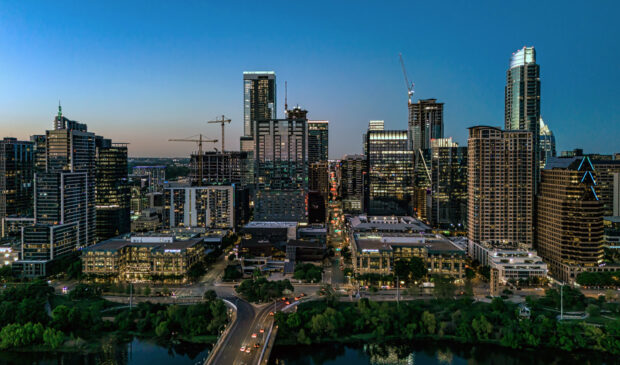City eyes expanded district plan for downtown and beyond
Thursday, May 15, 2025 by
Chad Swiatecki As city leaders prepare for a major overhaul of the Downtown Austin Plan, staff recommendations for the initiative could significantly expand the geographic area and project scope of the city’s long-range strategy for its urban core.
A May 9 memo from the Planning Department outlines a shift toward an expansive Center City/ Central District Plan that would incorporate the University Neighborhood Overlay area, much of the University of Texas campus, and the South Central Waterfront into a single planning framework for central Austin.
The revised boundaries propose expanding the area from 29th Street in the north to Bouldin Creek in the south, bordered by Lamar Boulevard to the west and I-35 to the east. Planning staff argue that high-density development and new infrastructure projects have already blurred the old lines that once defined downtown, making a more integrated planning approach necessary.
The new district-level plan would replace the 2011 Downtown Austin Plan as the city’s primary policy roadmap for downtown growth and development. In supporting documents, staff described the update as a response to more than a decade of rapid urbanization, major public investments, and shifting economic and cultural dynamics in the city center.
Projects like the expansion of the Austin Convention Center, the rollout of Project Connect’s light rail system, the redesign of Congress Avenue and the overhaul of I-35 have prompted city leaders to revisit how downtown and its surrounding neighborhoods are governed and connected.
Planning Director Lauren Middleton-Pratt said the goal of the expanded plan is to take a more regional view of central Austin’s interconnected districts, using consistent planning principles while allowing for the unique identity of each area.
“This broadening of the DAP update to a district plan with a larger geography acknowledges the regional nature of the urban core in the city and creates intentionality in planning for it,” she wrote in the memo.
The memo recommends launching the planning process this summer, with an estimated 18- to 21-month timeline that would conclude by the end of 2026. The projected $1.25 million cost is already included in the Planning Department’s Fiscal Year 2025 budget.
Consultants will be brought in to support the effort, which will begin with a pre-planning phase and continue with public engagement, plan development and eventual adoption.
The new plan will include a district analysis that breaks the area into smaller subdistricts for targeted assessments of land use, infrastructure and community character. This approach will build upon the seven “plan elements” of the original Downtown Austin Plan—covering transportation, housing, historic preservation and other key areas, while updating them to reflect current needs.
City staff will also create a “future places map,” that will guide land use decisions by defining place types that align with Austin’s broader goals for complete, connected communities.
In preparation for the update, staff conducted preliminary outreach in late 2024 with stakeholders and city departments. Key themes that emerged include improving pedestrian design and safety, supporting cultural and economic hubs, expanding housing diversity and affordability, and integrating parks and trails to support both community use and climate resilience. City staff noted that the area’s rapid change calls for flexible design standards, investment in infrastructure connectivity and tools to speed implementation.
The updated plan will also include a detailed implementation strategy, with specific recommendations for phasing, capital investment and public-private partnerships. “Quick win” projects — such as small-scale placemaking or safety improvements —will be identified to help generate early momentum following plan adoption. Longer-term actions may include development code amendments, funding proposals, and regulatory changes.
An equity assessment will be conducted by a third-party organization in collaboration with the community to evaluate the draft plan’s potential impacts. That process is intended to ensure that the update meets City Council’s directive to apply an equitable, resilient, and sustainable lens throughout the effort.
The Center City/Central District Plan is intended to complement other planning efforts in progress, including the Northeast District Plan and the forthcoming North River/East District Plan. If completed as scheduled, the plan could guide downtown policy and investment decisions through at least the mid-2030s.
In a prepared statement, Council Member Zo Qadri, who represents District 9 and much of downtown Austin, supported for the proposed update to the Downtown Austin Plan. Qadri described it as an opportunity to guide the next chapter of growth and investment in the city’s core.
“The Downtown Austin Plan update is a vital step toward shaping a more vibrant, inclusive, and sustainable future for the heart of our city. Downtown is Austin’s economic engine, a cultural anchor and civic common – and we must have a clear, committed vision for it’s investment in the decade ahead,” he wrote. “While there are very real economic uncertainties outside of our control, I remain optimistic that through thoughtful collaboration and strategic investment, we can ensure Downtown continues to thrive—not only as a destination, but as a place where people from all walks of life can live, work, and belong.”
Photo made available through a Creative Commons license.
The Austin Monitor’s work is made possible by donations from the community. Though our reporting covers donors from time to time, we are careful to keep business and editorial efforts separate while maintaining transparency. A complete list of donors is available here, and our code of ethics is explained here.
You're a community leader
And we’re honored you look to us for serious, in-depth news. You know a strong community needs local and dedicated watchdog reporting. We’re here for you and that won’t change. Now will you take the powerful next step and support our nonprofit news organization?




